Bonnieux is one of the most beautiful perched villages on the northern slopes of the Luberon. Some people call it the "Mont Saint-Michel of Provence".
It is part of the golden triangle Gordes - Roussillon - Bonnieux, but, unlike its two neighbours, the latter is less busy, which makes it more authentic.
The village comprises two churches, ramparts, sloping streets and several old buildings, all of which give Bonnieux a unique character.
As you can see, Bonnieux offers a wide variety of natural and historical sites within its territory.
Watch this short video on the Luberon!
Why you should visit Bonnieux
Bonnieux stretches from the Calavon valley to the Luberon crests and the Combe of Lourmarin, the access route to the southern Luberon.
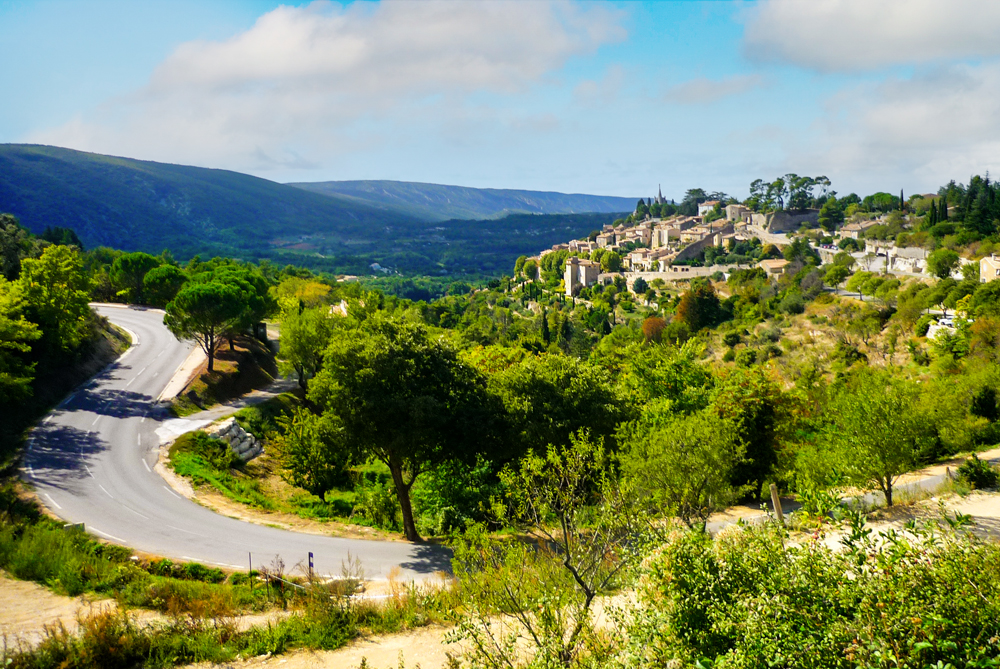
Arriving at Bonnieux from Lourmarin © French Moments
The commune is not far from Apt (12 km), the small capital of the Luberon. Avignon is 45 km away, Aix 40 km and Marseille 90 km.
The municipal territory covers 5112 hectares. It includes the village itself and, in the plain, the famous Pont Julien, built in Roman times (27 BC - 17 AD) on the Domitian road. On the crest of the Luberon mountain, the beautiful Cedar forest is a haven of cool air in summer.
Plan your trip
- 🛏 Find the best accommodations in the Luberon on Booking.com
- 🚙 Rent a car in Avignon or Marseille-Provence Airport
- 🙋♀️ Get the PASS CÔTE D'AZUR and take your pick from more than 100 amazing experiences!
- 🤩 Visit the beautiful Provençal region of Luberon
- 🚐 Join a 6-hour tour of Lourmarin, Bonnieux, Roussillon, and Gordes by air-conditioned minibus
- 🥗 Experience a black truffle hunting tour in a Luberon plantation
- 📚 Get our Guided Walk eBook of Bonnieux!
- 🚘 Discover Provence in a 2CV. Stroll along exceptional roads and enjoy a piece of Luberon all to yourself!
- 🗺 Download the village map of Bonnieux
- 🚻 Public toilets are located on "Rue d'Ittenheim" near Place du Terrail.
- 🚗 Park at the bottom or top of the old medieval centre: by the église neuve at bottom of the village (Parking du Pré du Bourg, Parking des Aires, Parking du stade) or at the top of the village (Parking des Croix).
- 🛍 A list of shops and restaurants in Bonnieux
Discover Bonnieux
Bonnieux stands on the northern slopes of the Petit Luberon, opposite the village of Lacoste.
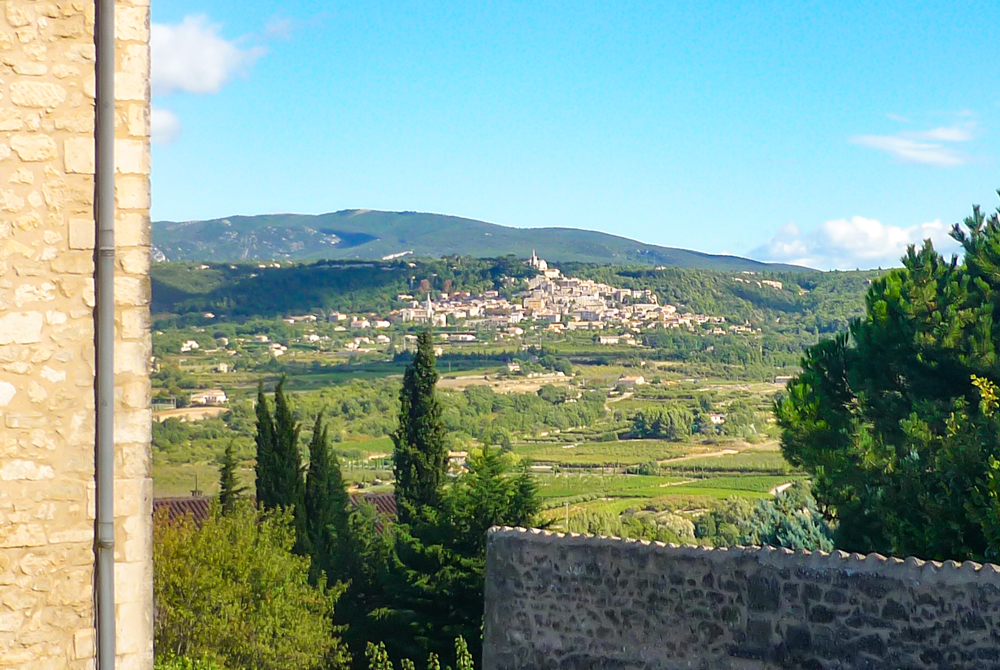
View of the village of Bonnieux from Lacoste © French Moments
The perched village lies on the north side of the Combe de Lourmarin which was and still is the only road that crosses the Luberon mountain range.
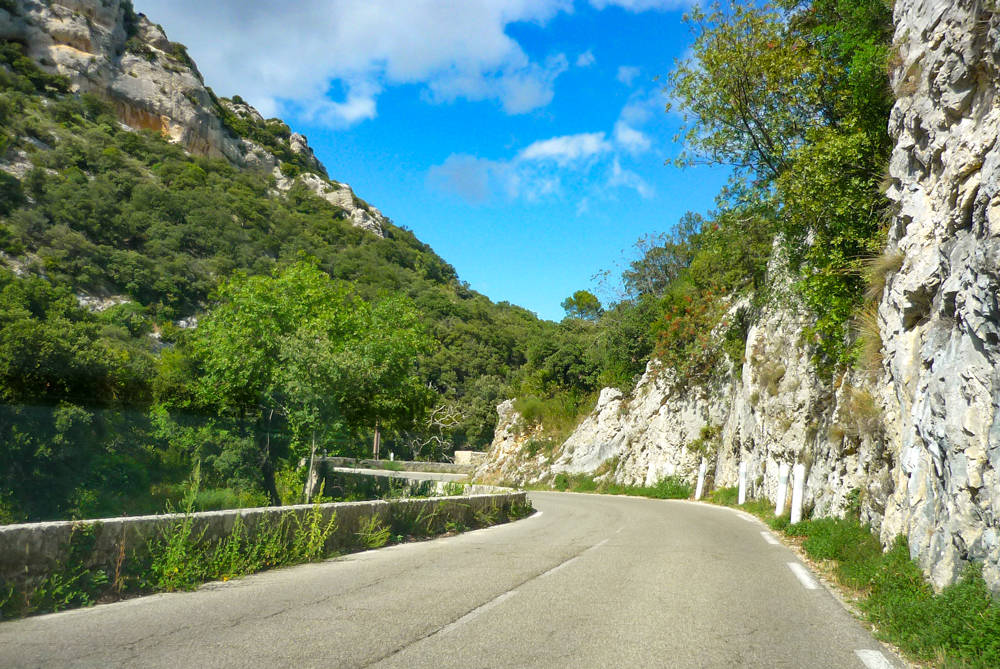
The D943 road crossing the Combe de Lourmarin © French Moments
The old church surrounded by hundred-year-old cedars dominates the village. Its panoramic terrace offers the visitor an exceptional view stretching from the Petit Luberon to the Mont Ventoux, passing through the Vaucluse mountains.

Sunset after a visit to Bonnieux © French Moments
A (very) steep village
The village elders had taken into account the constraints of often steep terrain and the roads criss-crossing the village. They built a network of lanes, paths, covered passages, calades and stairways to shorten journeys and promote relations between the lower and upper parts of the village.
Most of these charming pedestrian routes have been restored and embellished. To discover the village on foot, follow the itinerary punctuated by 15 informative panels that retrace the history of Bonnieux (about 1h30 to 2h).

Bonnieux © French Moments
A bit of history
Roman Bonnieux
The Romans occupied the Bonnieux and its surrounding during Ancient Times. The most important Roman heritage in the commune is the Pont Julien, built on the Via Domitia linking Spain and Italy (3 BC).

Pont Julien © French Moments
In addition, archaeologists have found remains of Gallo-Roman villas in the plain, close to the Via Domitia.
The Middle Ages
In the 6th century, monks founded a monastery on the site of the pagan temple of Mithra.
In 972, the village already had a fortress and walls.
Then 1103, the village of Bonnieux is mentioned under the name of Castrum Bonils. At that time, it was under the jurisdiction of the county of Forcalquier. In 1220, the village fell to the county of Provence.
Also in the 12th century, the Templars built the Saint-Sauveur chapel, which was the basis of the upper church.

The rooftops of the village © French Moments
From a papal land to a French village
At the beginning of the 14th century, Bonnieux became pontifical land (Comtat Venaissin) and remained so until 14 September 1791, when the village became French.
The fact that it belonged to the pontifical domain made it an enclave in the lands of the Count of Provence (and consequently in the kingdom of France), and thus gave it a special place in the history of the region. The village was Catholic, as opposed to Ménerbes, a Protestant stronghold.
On 12 August 1793, the French administration transferred Bonnieux from the département of Bouches-du-Rhône to that of Vaucluse.

Rue de la République (old postcard)
Places to see in Bonnieux
Walking tour itinerary
From the Place du Terrail in the lower part of the village, take the Rue Victor Hugo, Place du 4 Septembre, Rue JB Aurard, Rue Voltaire.
Climb the steps of Rue des Pénitents Blancs to reach the old church and the belvedere.
Take the lane that joins the parking des Croix. Return to the village via Rue Droite and Rue de la République.
Eglise Neuve
The new church dates from 1870. In the shape of a Latin cross, the building contains many objects from the old church: four 16th century paintings representing scenes from the Passion of Christ (the flagellation, the crowning with thorns, Christ before Pilate and Jesus carrying the Cross).
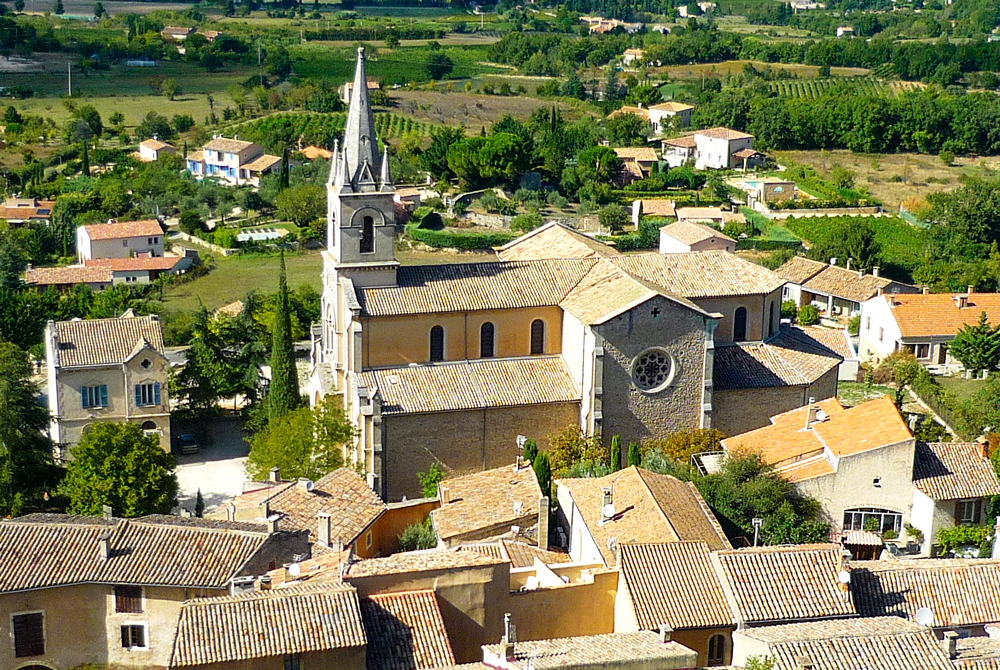
Eglise Neuve © French Moments
Anecdote
The new church does not belong to the commune, unlike most churches in France, which were requisitioned during the French Revolution. It was built much later and is the result of a private subscription. It is an alternative to the other church in Bonnieux, known as the "old church" or "high church". Because of its difficult access via a staircase of 86 steps, it was considered "deadly for all the suffering and infirm members of the parish". It now belongs to the Archdiocese of Avignon.

Eglise Neuve at the bottom of the village © French Moments
Hôtel de Rouvil
The Hôtel de Rouvil is a beautiful 18th century residence and the former home of a notable Bonnieux family. It housed the town hall from 1859.
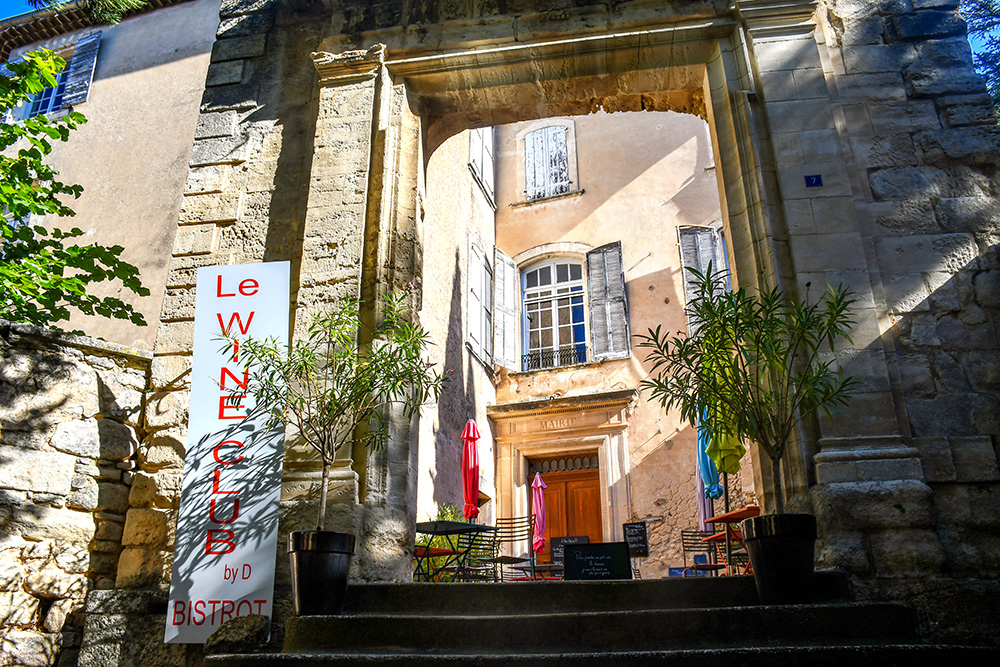
Hôtel de Rouvil © French Moments
Because of its location in the upper part of the village and its difficult access, the town hall moved to the lower part of the village in 2006.
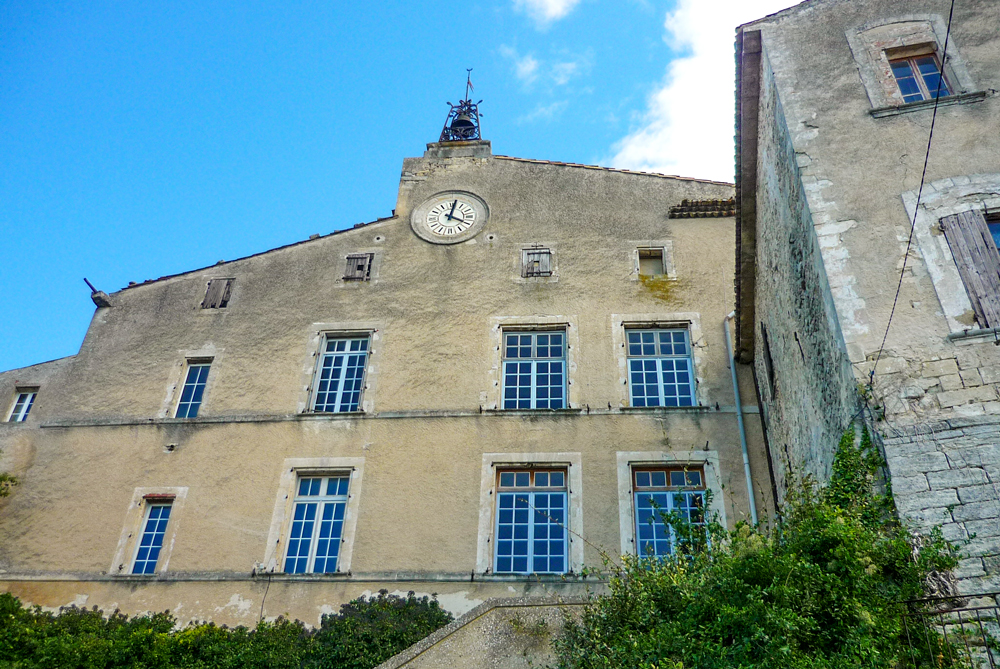
The rear of the Hôtel de Rouvil © French Moments
Musée de la boulangerie
The small bakery museum occupies the building of an old bread oven. It invites you to discover the world of "baking", from the wheat field to the slices of toast!

The Bakery Museum © French Moments
The museum will show you all the stages of bread making, from the tools to the cereals and the clothing.
UPDATE: When we last visited the village (November 2023), the bakery museum was no longer open to visitors.
Rue Droite
This cobbled street is one of the oldest in the village still visible. The Rue Droite is a treasure trove of small-scale heritage. Discover old houses, a wheel fountain and the remains of ramparts.

Under the arch in Rue Droite © French Moments
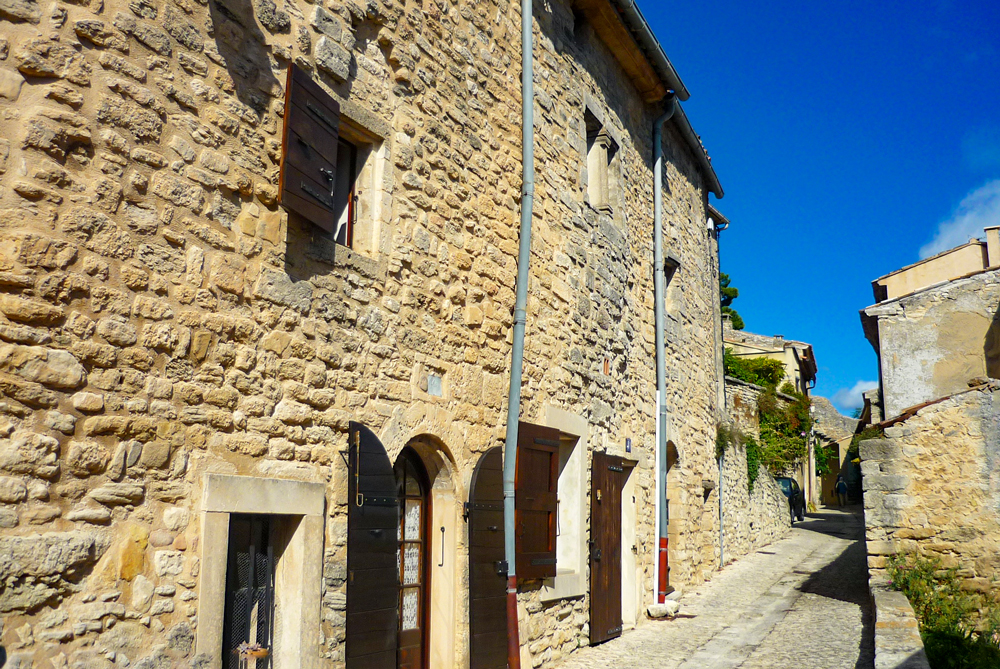
Rue Droite: an old street crossing the village © French Moments
Porte du Castellas
You can see the remains of a medieval gate to the east of the village. It is known as the Porte du Castellas or Portail des Chèvres and was probably the only entrance to Bonnieux from the road to Lourmarin.
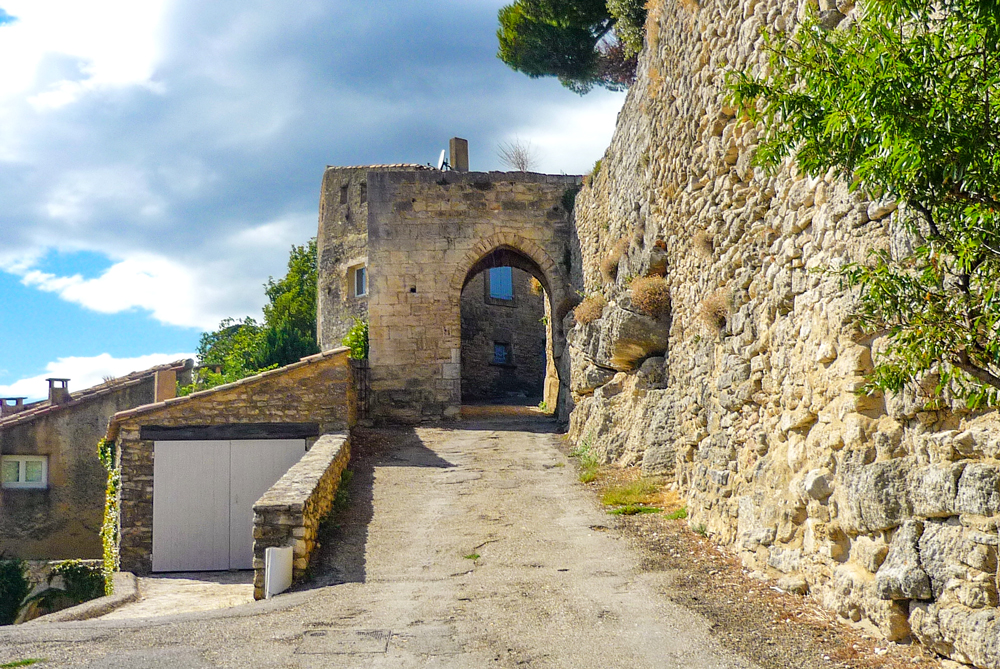
The medieval gate of Porte du Castellas © French Moments
On the outside, the fortification is made of well-cut stones assembled around the gate, which consists of a triple vault.
On the north side, you can still make out the remains of a construction that may have been a guardhouse.
Rue des Pénitents blancs
Magnificent stone staircases lead you to the belvedere of Bonnieux.
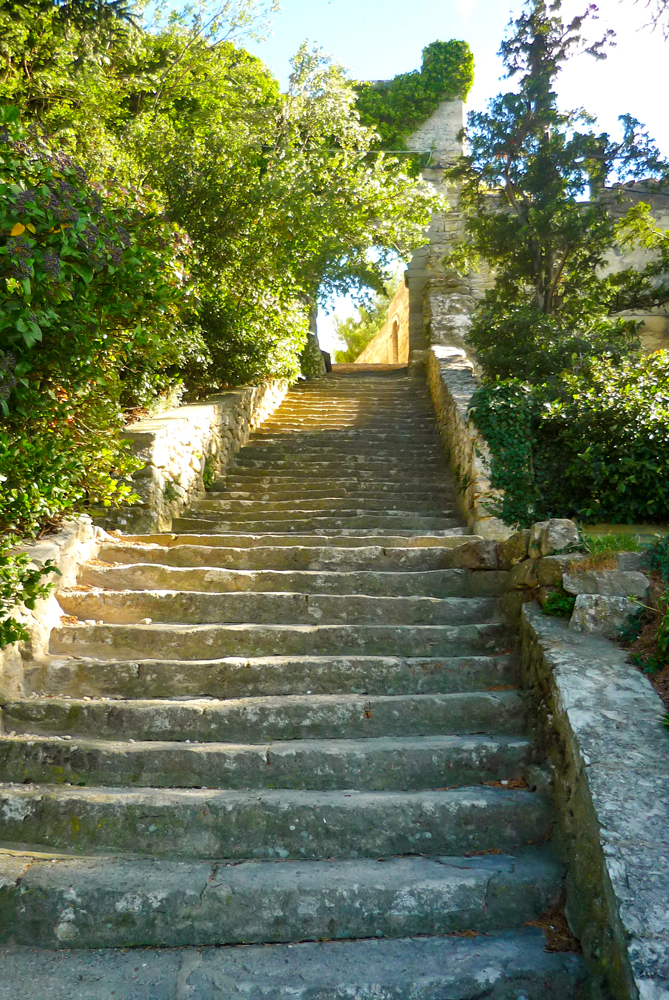
The stairs leading to the upper church © French Moments
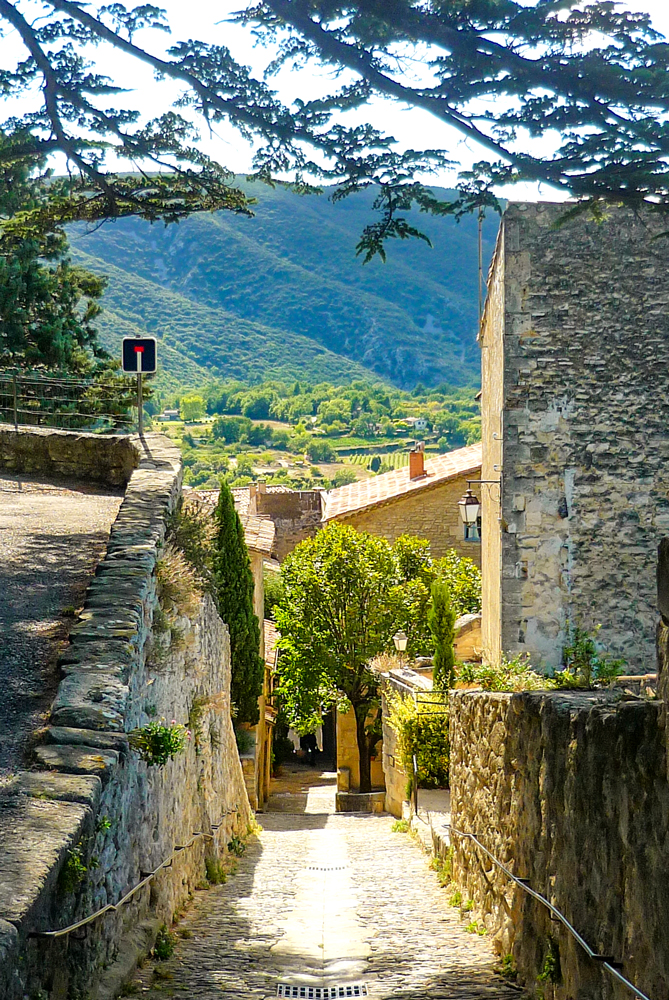
A calade © French Moments
Eglise Haute
At an altitude of 425 metres, the old church dominates the village of Bonnieux.

Eglise Haute © French Moments
The Eglise Haute (or Vieille Eglise) dates back to the 12th century and is a mixture of Gothic and Romanesque. Indeed, it has a Romanesque section and two side chapels added later.
The interior has a large 16th century altarpiece, a 17th century high altar, numerous works of art and an 18th century organ.
Today, parishioners use it mainly for Sunday masses, ceremonies, weddings and funerals.
Note: the church is only open in summer and at Christmas for the Nativity scene.

Eglise Haute © French Moments
Belvedere
Below the church is the famous belvedere of Bonnieux.
This viewpoint offers a breathtaking view of the lower part of the village of Bonnieux, the agricultural plain, the Calavon valley, the neighbouring villages (Gordes, Roussillon), the Vaucluse mountains and the Mont Ventoux.

The village view from the belvedere © French Moments

The Cavalon valley © French Moments

A view to Roussillon and the Monts de Vaucluse © French Moments
An orientation table allows you to locate the main villages and natural sites in the region.
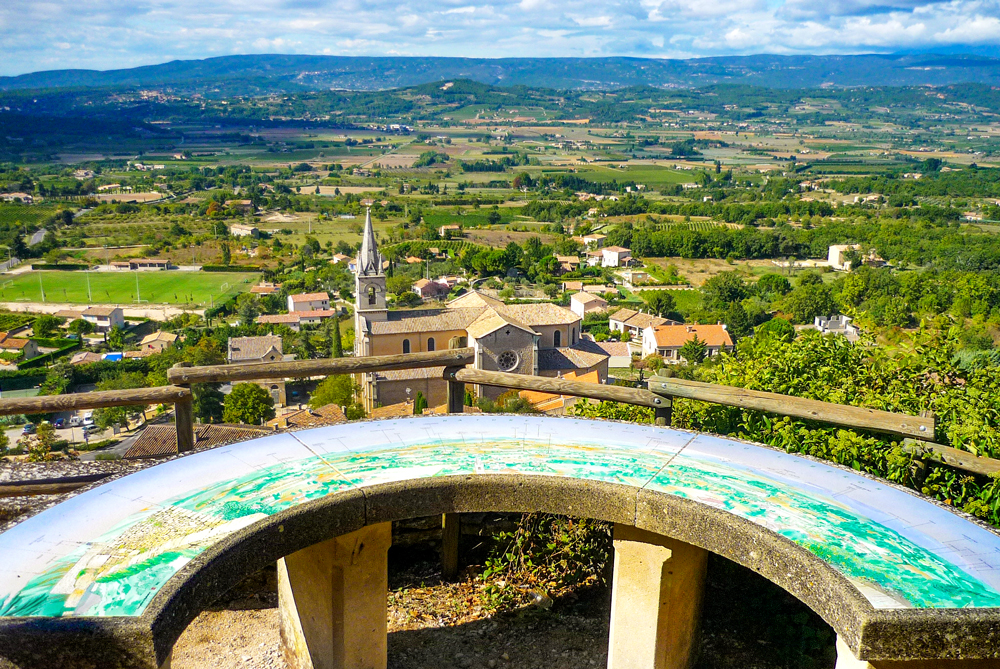
The orientation table at the belvedere © French Moments
The place is perfect for unforgettable photos of you or your friends!
Cemetery of Bonnieux
About 300 metres from the old church is the cemetery of Bonnieux offers an immense panorama on the surrounding countryside of the Luberon and in the distance towards the Mont Ventoux.

The cemetery © French Moments
Watch my guided walk of Bonnieux
A 36-minute video that starts in the lower district of Bonnieux and climbs to the church and the Castellas at the top of the village.
More photos of the village

The village of Bonnieux © French Moments
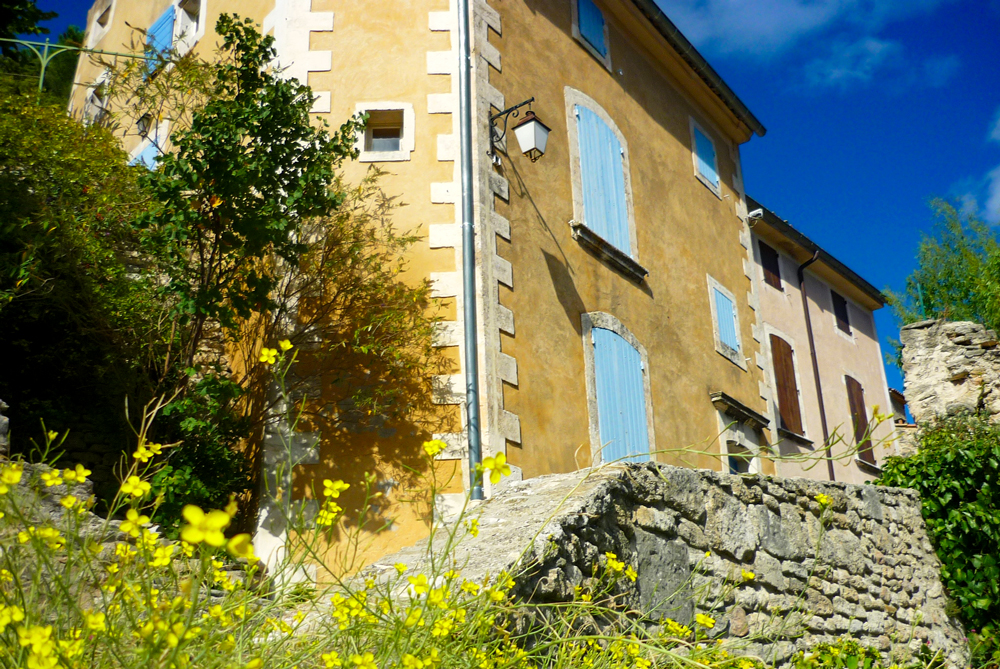
In the village © French Moments
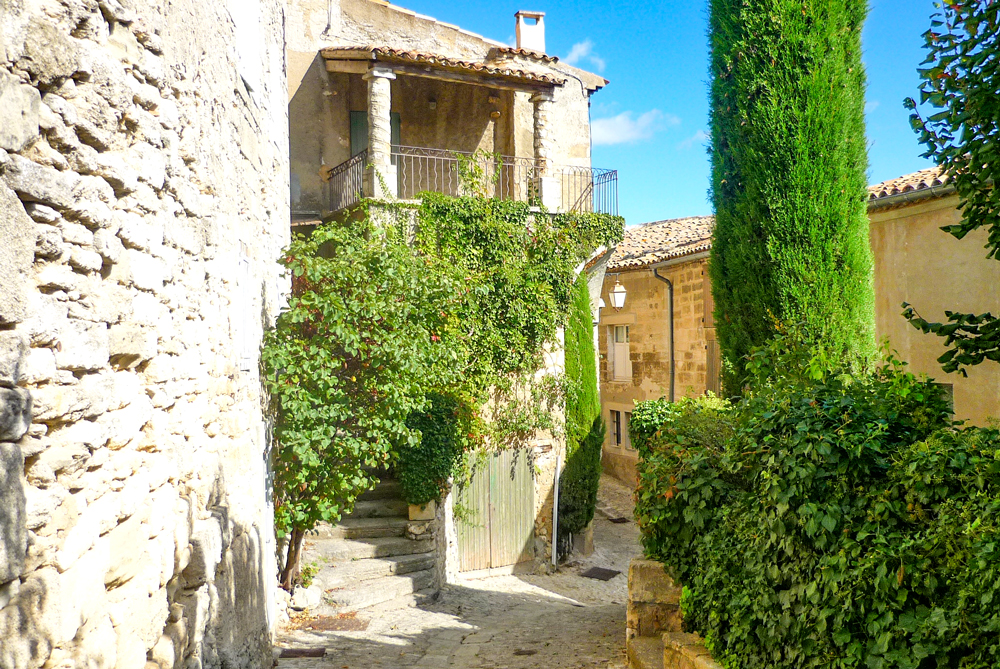
In the narrow streets of the village © French Moments

The centre of the village © French Moments
Places to see around Bonnieux
The territory of the Bonnieux commune is full of interesting sites to discover, between the plain and the mountains.
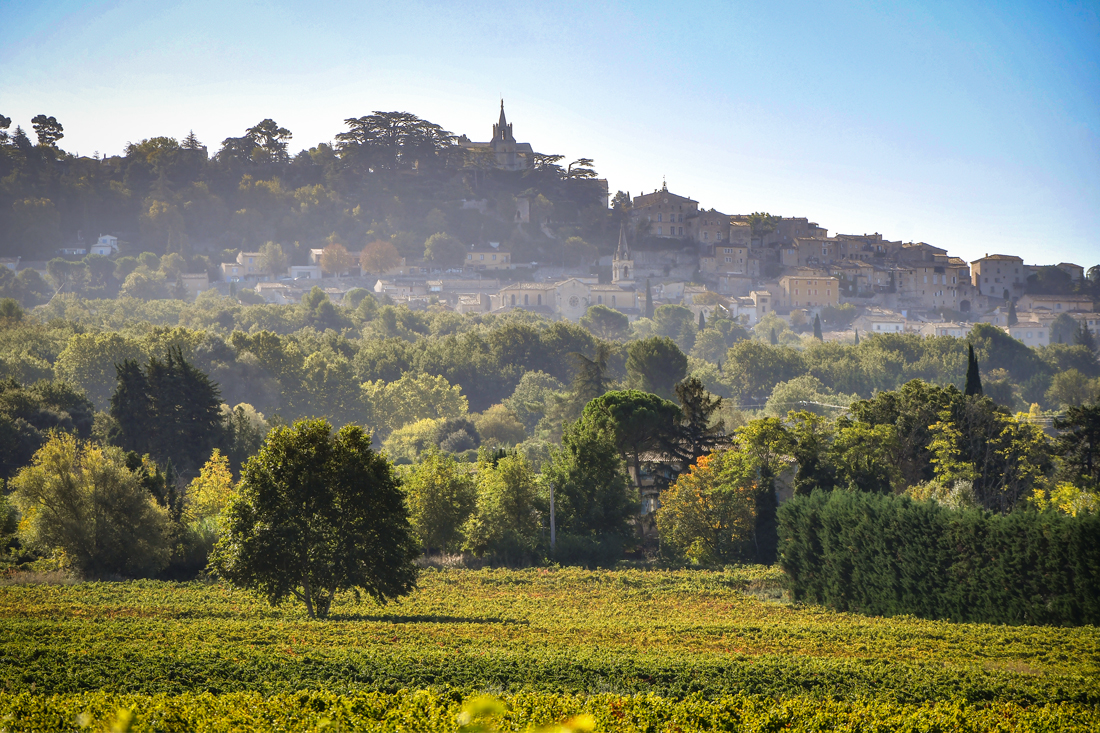
Bonnieux early morning © French Moments
Pont Julien
The Pont Julien is a Roman bridge dating back to the year 3 BC, 5 km north of Bonnieux
The bridge was located on the Domitian Way (via Domitia). This Roman road linked Narbonne (Colonia Narbo Martius) to Turin (Augusta Taurinorum). It owes its name to the proximity of Apt, then called Colonia Apta Julia.
The 80-metre-long bridge consists of three semicircular arches.

Pont Julien © French Moments
The old bridge was part of the road network until 2005, more than 2,000 years of operation! Today, a new bridge nearby preserves the old bridge, which can be crossed on foot.
Prieuré de Saint-Symphorien
The Saint-Symphorien priory of Bonnieux is an ancient priory featuring a Romanesque bell tower. The most remarkable feature of the priory is indeed its 11th century bell tower, which stands alone among the vegetation.

Saint-Symphorien Priory © French Moments
The priory is now privately owned and overlooks the old road from Marseille to Apt in the Aigue Brun valley. You will find the estate near the intersection of the D943 and D113 roads. More info...
Tour Philippe
Here is a monument that catches the eye of all visitors and onlookers on the road to the Cedar Forest.
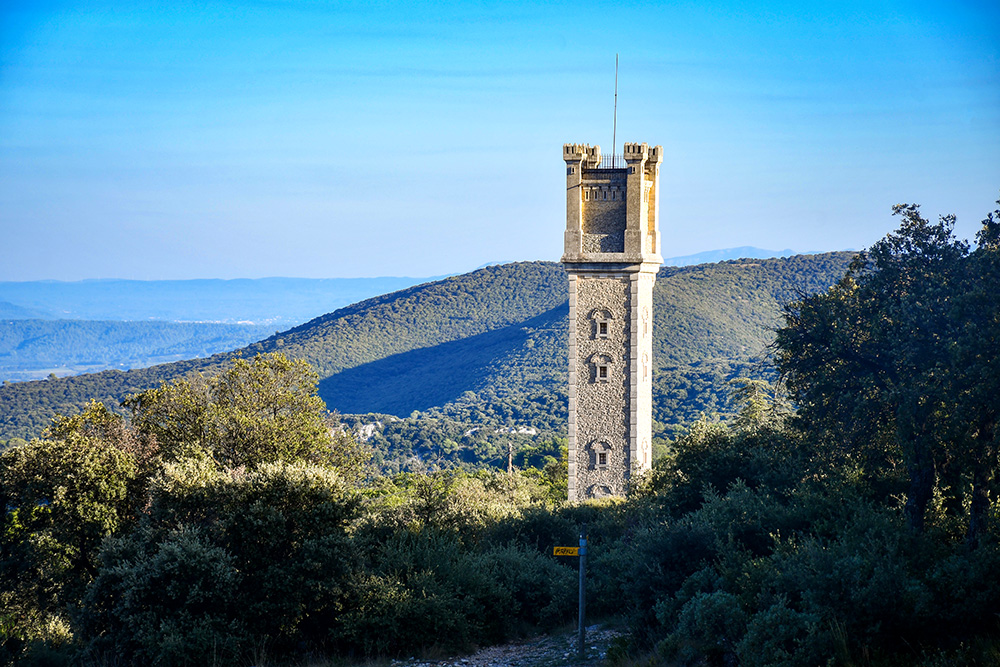
Tour Philippe © French Moments
In 1885, Philippe Audibert, an artistic genius from Bonnieux, decided to build a tower in order to realise a crazy dream. That of having a view of the Mediterranean Sea from the Luberon!
However, it is impossible to enter the Tour Philippe (Philippe Tower) and you will never know if you can actually see the sea from the top of the five-storey tower!
Les Bories
Bories are dry stone huts that served as temporary or seasonal shelters for farmers working on plots of land far from their homes.
![Bories Bonnieux © Art Anderson - licence [CC BY-SA 3.0] from Wikimedia Commons Bories Bonnieux © Art Anderson - licence [CC BY-SA 3.0] from Wikimedia Commons](http://frenchmoments.eu/wp-content/uploads/2023/01/Bories-Bonnieux-©-Art-Anderson-licence-CC-BY-SA-3.0-from-Wikimedia-Commons-scaled.jpg)
A borie in Bonnieux © Art Anderson - licence [CC BY-SA 3.0] from Wikimedia Commons
Around Bonnieux, you can discover two bories sites:
Near the Cedar Forest, the Enclos des Bories is made up of twenty or so dry stone huts spread over four hectares.
To the east of the village, the Claparèdes plateau also has many 19th century bories.
The Cedar Forest
Before leaving Bonnieux, don't forget to take a walk in the magnificent cedar forest. The Forêt de Cèdres spreads out at an altitude of more than 700 metres over the communes of Bonnieux, Lacoste and Ménerbes.
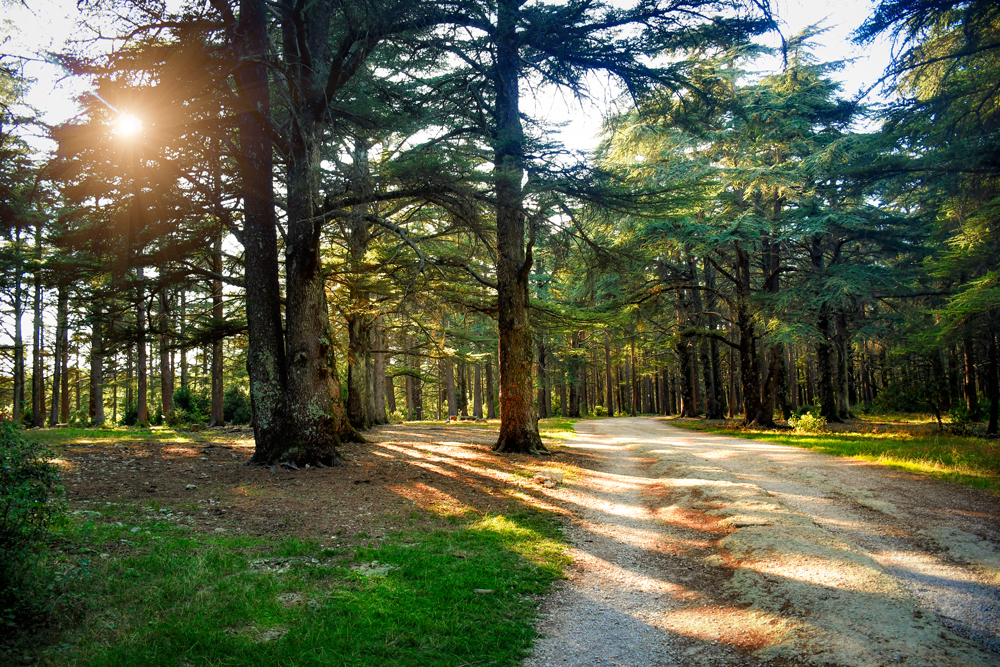
Forêt des Cèdres © French Moments
The cedar forest was originally planted with seeds from the Moroccan Atlas in 1862.
In 1952, a fire destroyed a large part of the surrounding trees. Cedars, more resistant, took the place of the burnt trees. Today, the site is home to the largest cedar forest in Europe.
Several signposted routes offer the possibility of continuing the walk in the forest.
The traditional market of Bonnieux
The traditional Provencal market of Bonnieux takes place all year round, every Friday from 9am to 1pm. It occupies the Place du Terrail (i.e. Place Gambetta) at the bottom of the village.
![Bonnieux Market © Doogsta - licence [CC BY 2.0] from Wikimedia Commons Bonnieux Market © Doogsta - licence [CC BY 2.0] from Wikimedia Commons](http://frenchmoments.eu/wp-content/uploads/2023/01/Bonnieux-Market-©-Doogsta-licence-CC-BY-2.0-from-Wikimedia-Commons-scaled.jpg)
At the local market © Doogsta - licence [CC BY 2.0] from Wikimedia Commons
You will discover the know-how of Provençal craftsmen and the stalls of local producers.
The wines of Bonnieux
The commune produces AOC Ventoux and Luberon wines. Wines that are not AOC can claim, after approval, the label Vin de pays d'Aigues.
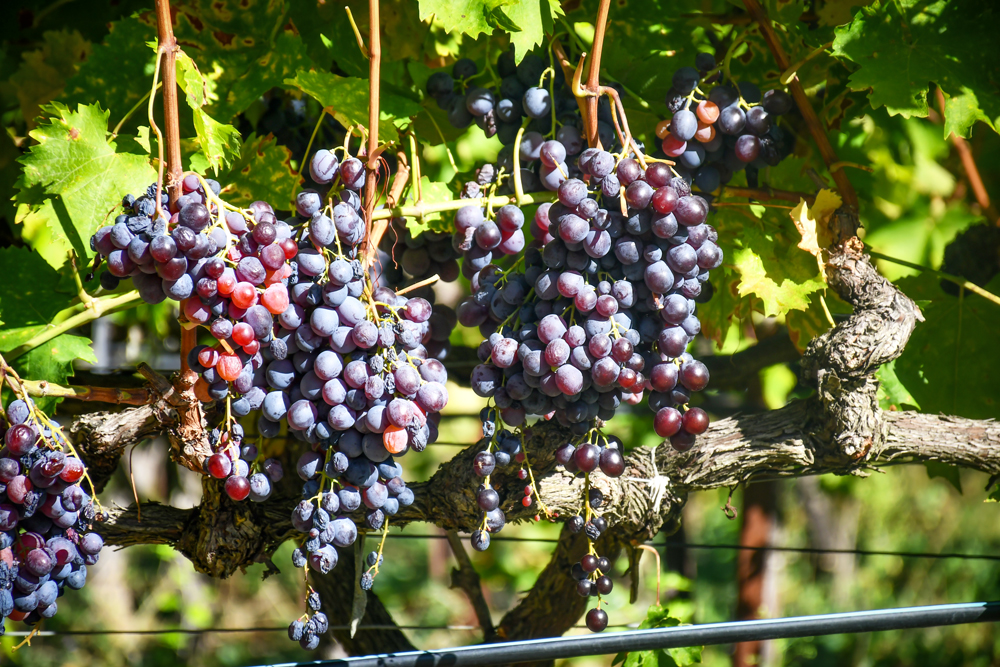
A vine in the Bonnieux countryside © French Moments
La Canorgue
Pope Benedict XIV made the wine fief of La Canorgue a county on 24 April 1747. Today the Château de la Canorgue is a wine estate that has been in the same family for 5 generations. Its name comes from canourgue which means "canon" (in French, chanoine).
![La Canorgue © Ainars Brūvelis - licence [CC BY-SA 3.0] from Wikimedia Commons La Canorgue © Ainars Brūvelis - licence [CC BY-SA 3.0] from Wikimedia Commons](http://frenchmoments.eu/wp-content/uploads/2023/01/La-Canorgue-©-Ainars-Brūvelis-licence-CC-BY-SA-3.0-from-Wikimedia-Commons.jpg)
La Canorgue © Ainars Brūvelis - licence [CC BY-SA 3.0] from Wikimedia Commons
The charm of the estate seduced Ridley Scott for one of his films starring Russell Crowe and Marion Cotillard. Based on a novel by Peter Mayle, A Good Year (2006) was filmed at Château de la Canorgue.
La cave coopérative de Bonnieux
The Bonnieux winery (cave coopérative de Bonnieux) was founded in 1920 by a few winegrowers determined to pool their production resources. It was the first wine cooperative cellar founded in the Vaucluse département.

Cave Coopérative de Bonnieux © French Moments
You will find the winery to the north of the village, along the D36 in the old station area. The cellar shop is open every day except Sundays and public holidays.
Practical Information
Here are some pages from our blog and other websites to find out more about this Provencal destination.
- Discover the hilltop villages of the Luberon
- Find out more about Provence-Alpes-Côte d'Azur
- The official tourist office of the area
- Click here to book your accommodation in the Luberon or browse the map below:
Shops and restaurants in Bonnieux
Here is a list of shops and restaurants in Bonnieux. Please note that this list is indicative and may change over time.
Shops and amenities in Bonnieux:
Boulangerie Cecile et Jeremy (bakery)
4 Rue Victor Hugo - Closed on Tuesday - facebook
Boucherie Isnard (butchery)
18 Rue Victor Hugo - Closed on Sunday and Monday
Pepin et Olivette (gourmet grocery store)
20 Rue Victor Hugo - Open Tuesday to Sunday (Closed on Monday and on Sunday afternoon) - facebook
Supérette - Utile (convenience store)
Rue Jean Baptiste Aurard - Open Monday to Saturday (Closed on Sunday)
Presse (newsagent)
10 Avenue de la Gare - Open every day
Pharmacie (pharmacy)
145 Avenue des Tilleuls - Closed on Sunday
Agence postale (post office)
Rue des Aires de Foulage (in the premises of the Maison du Livre et de la Culture) - Closed on Sunday - website
Médiathèque (library and media centre)
Rue des Aires de Foulage - Closed on Saturday afternoon and Sunday - Access to the media library and consultation of documents on site are free. However, to borrow documents from home, you need a subscription. website
Sun-E-Bike (Bike rental service)
1 Avenue Clovis Hugues - website
Cave coopérative de Bonnieux (winery)
Place de la Gare - Closed on Saturday and Sunday - website
Cafés and restaurants in Bonnieux:
Le César (restaurant)
Place de la Liberté - website
L'Arôme (restaurant)
2 Rue Lucien Blanc - website
Casa Bonilis (restaurant)
4 Place Carnot - facebook
Le Saint-André (restaurant)
1 Place de la Liberté - facebook
Le Fournil (restaurant)
5 Place Carnot - facebook
Un p'tit Coin de Cuisine (restaurant)
Place Gambetta - facebook
Le Kosy (restaurant and tea room)
Place Gambetta - website
La Flambée (restaurant)
2 Place du Quatre Septembre - facebook
Glacier-Crêperie Le Tinel (Ice-cream and crêpes)
Place Gambetta - Open every day mid-spring to mid-autumn
The nearest supermarkets to Bonnieux:
Lidl in Apt (13 km / 8 mi) - website
E. Leclerc in Apt (14 km / 9 mi) - website
Super U in Le Coustellet (14 km / 9 mi) - website
Super U in Puyvert (17 km / 10.5 mi) - website
What to do in the Luberon
Be inspired by a list of things to do in the Luberon:
Pin Bonnieux on Pinterest


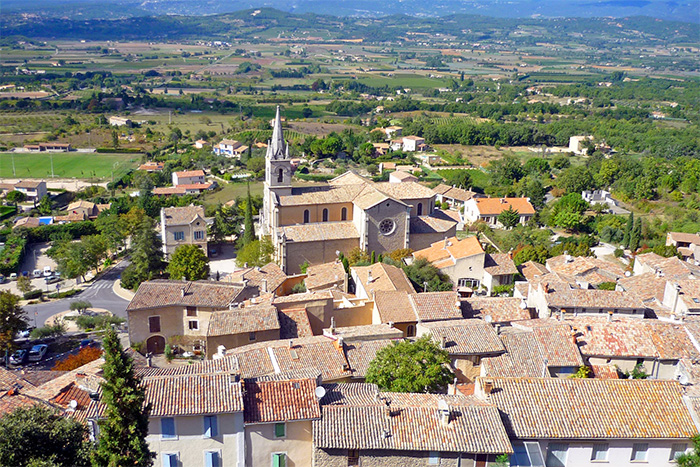

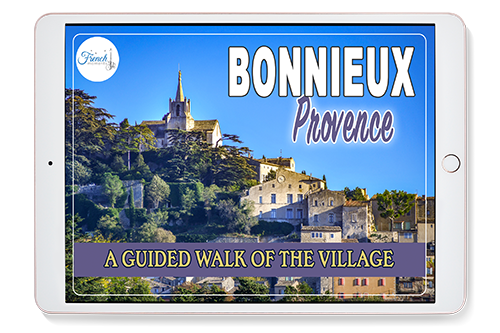



I find all of your writings enjoyable and interesting. I send them on to a friend who is confined to a wheelchair and can no longer travel to Strasbourg where she once lived. We both await your next entry. I want to return to France!!!
Thank you.
Thank you very much Cecelia for your message. I’m glad to hear that you look forward to my newsletters! See you soon for new adventures in France!
I really enjoy your Provence information. I have family who recently moved there (from Australia and the UK) so I am trying to learn about the area. You are my "go to" website. Thank you for such enjoyable articles!
Thank you Maureen for your kind message and I’m glad to hear this blog inspires you. I am currently working on a discovery-walk video in the streets of Bonnieux and it should be live in the next couple of weeks 🙂